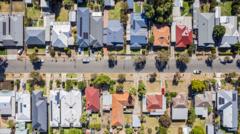The upcoming federal election in Australia has put the housing crisis on the front burner. With skyrocketing house prices, soaring rents, and insufficient social housing, many Australians are struggling to secure a home. Candidates from the Labor Party and the Liberal-National Coalition have both pledged to tackle these pressing issues, amid ongoing cost-of-living pressures and concerns about global economic developments.
Why is the housing market in Australia so under pressure? The short answer lies in a severe supply-demand imbalance. The rapid growth in population hasn't been matched with adequate housing construction, especially in major urban centers like Sydney and Melbourne, leading to an expensive real estate landscape. Compounding this problem are strict planning laws that limit where new homes can be built, leaving many areas struggling for space.
On top of house-buying woes, renting is no easier, with rates rising dramatically—36.1% on average since the pandemic began. This has driven weekly rents in cities like Sydney to an average of A$773, putting it among the least affordable cities worldwide.
Is immigration to blame for worsening housing conditions? Surprisingly, experts argue that it's not a major factor. Many newcomers are temporary migrants who do not significantly impact the housing market. Statistics reveal that foreign buyers represent less than one percent of home sales in Australia, indicating that the perceived strain might be more of a myth than reality.
The parties' proposed solutions reflect their approaches to the issue. Labor aims to build 1.2 million homes by 2029, while the Coalition targets 500,000. Labor's A$33 billion plan includes measures for first-time buyers, such as shared equity loans, whereas the Coalition emphasizes reducing immigration and foreign investment to ease housing demand.
Despite these plans, analysts warn that they may fall short. The Urban Development Institute of Australia noted that current targets might not be met, projecting a significant shortfall in new housing units. As Australians await the election outcome, the consensus is clear: solving the housing crisis will require more aggressive and holistic strategies than those currently proposed.
While there's now heightened attention to these issues, it underscores the urgent need for action to avoid further crises. It seems the quest for affordable housing will remain a central concern for the foreseeable future.
Why is the housing market in Australia so under pressure? The short answer lies in a severe supply-demand imbalance. The rapid growth in population hasn't been matched with adequate housing construction, especially in major urban centers like Sydney and Melbourne, leading to an expensive real estate landscape. Compounding this problem are strict planning laws that limit where new homes can be built, leaving many areas struggling for space.
On top of house-buying woes, renting is no easier, with rates rising dramatically—36.1% on average since the pandemic began. This has driven weekly rents in cities like Sydney to an average of A$773, putting it among the least affordable cities worldwide.
Is immigration to blame for worsening housing conditions? Surprisingly, experts argue that it's not a major factor. Many newcomers are temporary migrants who do not significantly impact the housing market. Statistics reveal that foreign buyers represent less than one percent of home sales in Australia, indicating that the perceived strain might be more of a myth than reality.
The parties' proposed solutions reflect their approaches to the issue. Labor aims to build 1.2 million homes by 2029, while the Coalition targets 500,000. Labor's A$33 billion plan includes measures for first-time buyers, such as shared equity loans, whereas the Coalition emphasizes reducing immigration and foreign investment to ease housing demand.
Despite these plans, analysts warn that they may fall short. The Urban Development Institute of Australia noted that current targets might not be met, projecting a significant shortfall in new housing units. As Australians await the election outcome, the consensus is clear: solving the housing crisis will require more aggressive and holistic strategies than those currently proposed.
While there's now heightened attention to these issues, it underscores the urgent need for action to avoid further crises. It seems the quest for affordable housing will remain a central concern for the foreseeable future.





















